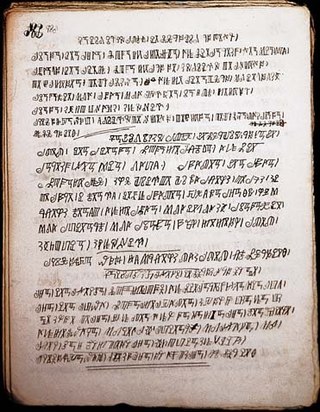| Bamum | |
|---|---|
| Shüpamom | |
| ꛀꛣꚧꚳ | |
| Region | Cameroon, Nigeria |
| Ethnicity | Bamum people |
Native speakers | 420,000 (2005)[1] |
| Dialects |
|
| Latin script, Bamum syllabary (being revived) | |
| Language codes | |
| ISO 639-3 | bax |
| Glottolog | bamu1253 |
 Page from a manuscript in the Bamum script | |
Bamum (Shü Pamom [ʃŷpǎˑmə̀m] 'language of the Bamum', or Shümom 'Mum language'), also known as Shupamem, Bamun, or Bamoun, is an Eastern Grassfields language of Cameroon, with approximately 420,000 speakers.[1] The language is well known for its original script developed by King Njoya and his palace circle in the Kingdom of Bamum around 1895. Cameroonian musician Claude Ndam was a native speaker of the language and sang it in his music.[2]
Phonology[edit]
Bamum has tone, vowel length, diphthongs and coda consonants.
Vowels[edit]
Nchare claims ten diphthongs, only eight of which (excluding /ɔ/ and /o/) have a length distinction.[3] Matateyou shows normal and long examples of all ten vowel qualities. The orthography in angle brackets was based on the General Alphabet of Cameroon Languages as used by Matateyou.[4]
| Front | Central | Back | |||
|---|---|---|---|---|---|
| Unrounded | Rounded | Unrounded | Unrounded | Rounded | |
| Close | i ⟨i⟩ iː ⟨ii⟩ | y ⟨ü⟩ yː ⟨üü⟩ | ɯ ⟨ʉ⟩ ɯː ⟨ʉʉ⟩ | u ⟨u⟩ uː ⟨uu⟩ | |
| Mid | e ⟨e⟩ eː ⟨ee⟩ | ə ⟨ə⟩ əː ⟨əə⟩ | o ⟨o⟩ oː ⟨oo⟩ | ||
| Open-mid | ɛ ⟨ɛ⟩ ɛː ⟨ɛɛ⟩ | ɔ ⟨ɔ⟩ ɔː ⟨ɔɔ⟩ | |||
| Open | a ⟨a⟩ a ⟨aa⟩ | ||||
Consonants[edit]
The consonants are displayed as following:[5][4]
| Labial | Alveolar | Palatal | Velar | Labial- velar |
Glottal | ||||
|---|---|---|---|---|---|---|---|---|---|
| Plosive | Plain | Voiceless | p ⟨p⟩ | t ⟨t⟩ | k ⟨k⟩ | k͡p ⟨kp⟩ | ʔ ⟨ʼ⟩[a] | ||
| Voiced | b ⟨b⟩[b] | d ⟨d⟩[c] | ɡ ⟨g⟩[d] | g͡b ⟨gb⟩ | |||||
| Prenasal | Voiceless | ᵐp ⟨mp⟩ | ⁿt ⟨nt⟩ | ᵑk ⟨ŋk⟩ | ᵑ͡ᵐk͡p ⟨ŋkp⟩ | ||||
| Voiced | ᵐb ⟨mb⟩ | ⁿd ⟨nd⟩ | ᵑɡ ⟨ŋg⟩ | ᵑ͡ᵐg͡b ⟨ŋgb⟩ | |||||
| Fricative | Plain | Voiceless | f ⟨f⟩ | s ⟨s⟩ | ʃ ⟨sh⟩ | ||||
| Voiced | β[b] ⟨ɓ⟩[e] | v ⟨v⟩ | z ⟨z⟩[f] | ʒ ⟨j⟩[g] | ɣ ⟨gh⟩ | ||||
| Prenasal | Voiceless | ᶬf ⟨mf⟩ | ⁿs ⟨ns⟩ | ᶮʃ ⟨nsh⟩ | |||||
| Voiced | ᶬv ⟨mv⟩ | ⁿz ⟨nz⟩ | ᶮʒ ⟨nzh⟩ | ||||||
| Nasal | m ⟨m⟩ | n ⟨n⟩ | ɲ ⟨ny⟩ | ŋ ⟨ŋ⟩ | ŋ͡m ⟨ŋm⟩ | ||||
| Rhotic | r ⟨r⟩ | ||||||||
| Approximant | Plain | l ⟨l⟩ | j ⟨y⟩ | w ⟨w⟩ | |||||
| Prenasal | ⁿj ⟨nj⟩ | ⁿw ⟨nw⟩ | |||||||
Tones[edit]
Bamum has four[6] or five tones.[7] Mateteyou's analysis includes a mid tone, while Nchare's analysis includes downstep.[6] Bamum distinguishes between lexical and grammatical tone.[8]
| Diacritic | Nchare | Matateyou |
|---|---|---|
| à | low | low |
| á | high | high |
| ā | ― | mid |
| ǎ | rising | rising |
| â | falling | falling |
| ꜜ | downstep | ― |
References[edit]
- ^ a b Bamum at Ethnologue (18th ed., 2015) (subscription required)
- ^ Kell, Cathy (14 September 2005). "Cameroon: Claude Ndam : Committed To Culture". Cameroon Tribune. Archived from the original on 2012-07-28. Retrieved 28 August 2015 – via AllAfrica.
- ^ Nchare 2012, pp. 39–40.
- ^ a b Matateyou 2002, pp. 37–38.
- ^ Nchare 2012, pp. 44, 46.
- ^ a b Nchare 2012, p. 63.
- ^ Matateyou 2002, p. 38.
- ^ Nchare 2012, p. 64.
Bibliography[edit]
- Matateyou, Emmanuel (2002). Parlons Bamoun. Paris: L'Harmattan. p. 38.
- Nchare, Abdoulaye Laziz (2012). The Grammar of Shupamem (PhD dissertation). New York University. ProQuest 996252918.
Further reading[edit]
- Bamum Scripts and Archives Project; Riley, Charles (2006-01-08). Towards the Encoding of the Bamum Script in the UCS (PDF) (Report).
Well, that’s interesting to know that Psilotum nudum are known as whisk ferns. Psilotum nudum is the commoner species of the two. While the P. flaccidum is a rare species and is found in the tropical islands. Both the species are usually epiphytic in habit and grow upon tree ferns. These species may also be terrestrial and grow in humus or in the crevices of the rocks.
View the detailed Guide of Psilotum nudum: Detailed Study Of Psilotum Nudum (Whisk Fern), Classification, Anatomy, Reproduction